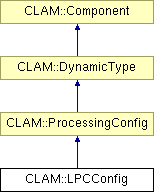CLAM::LPCConfig Class Reference
#include <LPC_AutoCorrelation.hxx>
Inheritance diagram for CLAM::LPCConfig:

Detailed Description
Definition at line 36 of file LPC_AutoCorrelation.hxx.
Public Member Functions | |
| DYNAMIC_TYPE_USING_INTERFACE (LPCConfig, 1, ProcessingConfig) | |
| DYN_ATTRIBUTE (0, public, unsigned, Order) | |
| The order of the polynomial used to fit the analyzed signal spectrum. | |
Protected Member Functions | |
| void | DefaultInit () |
| The concrete dynamic type constructor calls DefaultInit(). | |
Member Function Documentation
| CLAM::LPCConfig::DYNAMIC_TYPE_USING_INTERFACE | ( | LPCConfig | , | |
| 1 | , | |||
| ProcessingConfig | ||||
| ) |
| CLAM::LPCConfig::DYN_ATTRIBUTE | ( | 0 | , | |
| public | , | |||
| unsigned | , | |||
| Order | ||||
| ) |
The order of the polynomial used to fit the analyzed signal spectrum.
| void CLAM::LPCConfig::DefaultInit | ( | void | ) | [protected] |
The concrete dynamic type constructor calls DefaultInit().
This allows user to initialize his/her object. But we define DefaultInit() here because we don't want to force writting one DefaultInit() function for each concrete dynamic type. If a dynamic type concrete class defines some (not-default) constructors, this should also call the DefaultInit().
- See also:
- CopyInit()
Reimplemented from CLAM::DynamicType.
Definition at line 44 of file LPC_AutoCorrelation.cxx.
References CLAM::DynamicType::UpdateData().
The documentation for this class was generated from the following files:
 1.5.5
1.5.5